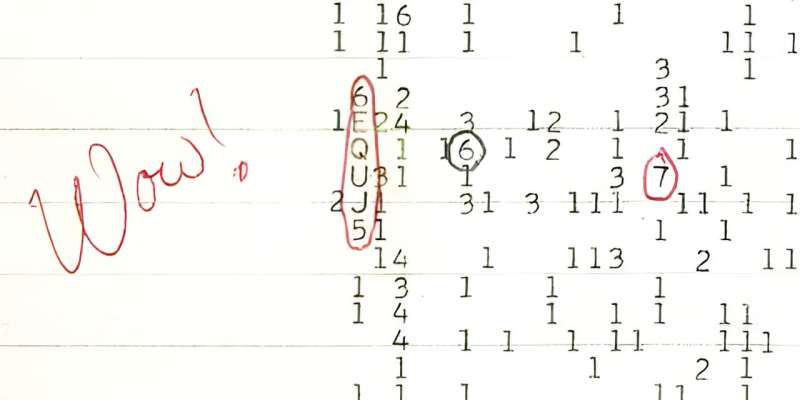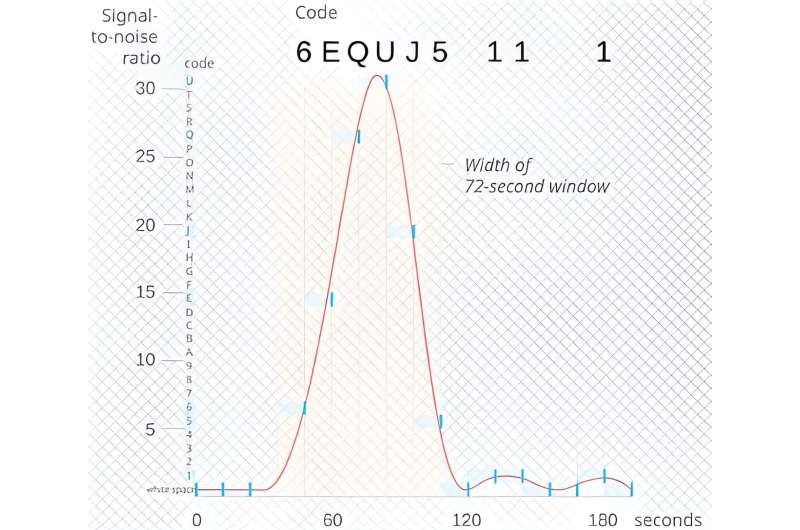This article has been reviewed according to Science X's editorial process and policies. Editors have highlighted the following attributes while ensuring the content's credibility:
fact-checked
preprint
trusted source
proofread
The Wow! Signal deciphered—it was hydrogen all along, study says

In 1977, astronomers received a powerful, peculiar radio signal from the direction of the constellation Sagittarius. Its frequency was the same as neutral hydrogen, and astronomers had speculated that any ETIs attempting to communicate would naturally use this frequency. Now the signal, named the Wow! Signal has become lore in the SETI world.
But what was it?
Beginning in the 1970s, the Ohio State University Big Ear radio telescope was used in the university's Search for Extraterrestrial Intelligence (SETI) program, which ran from 1973 to 1995. This program is the longest-running SETI program in history.
In 1977, Big Ear detected the peculiar signal that's taken on a life of its own. The Wow! Signal was a strong narrowband radio signal right near the frequency of neutral hydrogen. The Big Ear telescope is long gone now, but the effort to understand what the signal is lives on.
The signal lasted the full 72-second window in which Big Ear was able to observe it. A few days later, astronomer Jerry R. Ehman was looking over the data when he saw the signal on a computer printout. Astronomers had never seen anything like it, and he wrote "Wow!" beside it, and the name has stuck ever since.
The signal has another name: 6EQUJ5. This has been interpreted as a message hidden in the signal, but it really represents how the signal's intensity varied over time.

The signal generated a lot of excitement. Some thought it was extraterrestrial in origin, some thought it could come from some type of human-generated interference, and some thought it could be from an unexplained natural phenomenon.
New research shows that the Wow! Signal has an entirely natural explanation.
The research is titled "Arecibo Wow! I: An Astrophysical Explanation for the Wow! Signal." The lead author is Abel Méndez from the Planetary Habitability Laboratory at the University of Puerto Rico at Arecibo. It's available on the preprint server arXiv.
Arecibo Wow! is a new effort based on an archival study of data from the now-defunct Arecibo Radio Telescope from 2017 to 2020. The observations from Arecibo are similar to those from Big Ear but "are more sensitive, have better temporal resolution, and include polarization measurements," according to the authors.
"Our latest observations, made between February and May 2020, have revealed similar narrowband signals near the hydrogen line, though less intense than the original Wow! Signal," said Méndez.
Arecibo detected signals similar to the Wow! signal but with some differences. They're far less intense and come from multiple locations. The authors say these signals are easily explained by an astrophysical phenomenon and that the original Wow! signal is too.

"We hypothesize that the Wow! Signal was caused by sudden brightening from stimulated emission of the hydrogen line due to a strong transient radiation source, such as a magnetar flare or a soft gamma repeater (SGR)," the researchers write. Those events are rare and rely on precise conditions and alignments. They can cause clouds of hydrogen to brighten considerably for seconds or even minutes.
The researchers say that what Big Ear saw in 1977 was the transient brightening of one of several H1 (neutral hydrogen) clouds in the telescope's line of sight. The 1977 signal was similar to what Arecibo saw in many respects. "The only difference between the signals observed in Arecibo and the Wow! Signal is their brightness. It is precisely the similarity between these spectra that suggests a mechanism for the origin of the mysterious signal," the authors write.
These signals are rare because the spatial alignment between source, cloud, and observer is rare. The rarity of alignment explains why detections are so rare.
The researchers were able to identify the clouds responsible for the signal but not the source. Their results suggest that the source is much more distant than the clouds that produce the hydrogen signal. "Given the detectability of the clouds as demonstrated in our data, this insight could enable precise location of the signal's origin and permit continuous monitoring for subsequent events," the researchers explain.
The Wow! Signal was originally interpreted as a technosignature by many. By explaining where the signal came from, this research outlines a new source of false positives.
"Our hypothesis explains all observed properties of the Wow! Signal, proposes a new source of false positives in technosignature searches, and suggests that the Wow! Signal could be the first recorded event of an astronomical maser flare in the hydrogen line," the authors explain in their conclusion.
More information: Abel Méndez et al, Arecibo Wow! I: An Astrophysical Explanation for the Wow! Signal, arXiv (2024). DOI: 10.48550/arxiv.2408.08513
Journal information: arXiv
Provided by Universe Today





















